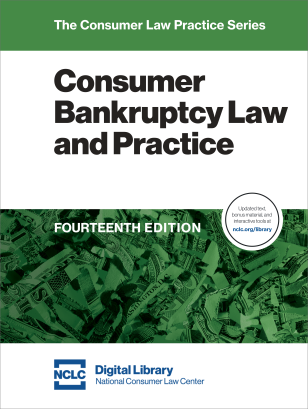Effective December 1, 2022, three amendments to the Bankruptcy Rules go into effect that deal with the debtor’s notice to creditors or the United States trustee. These changes have practical application to the practice of consumer bankruptcy law, in general simplifying that practice. The most helpful of the three for consumer bankruptcy practitioners is new Bankruptcy Rule 7004(i) that eliminates the need to name a specific officer when sending notice to a creditor.
As many consumer bankruptcy attorneys are well aware, compliance with Bankruptcy Rule 7004(h) is burdensome and has imposed unnecessary costs on debtors and their attorneys. It requires that service upon an insured depository institution in a contested matter or adversary proceeding must be made by certified mail upon an officer of the institution.
Unlike other rules that can be amended to address problems that arise, the Bankruptcy Rules Advisory Committee’s hands have been tied because the specific language in Rule 7004(h) was mandated by Congress. Effective December 1, 2022, however, one aspect of the rule has been clarified through a new subsection (i). This change should make compliance easier and eliminate a procedural trap that will help avoid disputes over whether service was proper.
Also discussed in this article are amendments to two other rules affecting consumer bankruptcy practice, Rule 3002 and Rule 5005. Not covered in this article are a number of rule changes to deal with small business debtor reorganizations under subchapter V of chapter 11.
Service Addressed to an Officer of the Institution—Rule 7004(i)
Courts have wrestled with whether the requirement in Rule 7004(h) that service must be “addressed to an officer of the institution” means that a specific officer must be named, or that service can simply be sent in care of “Officer” or a specific office or title such as “President.” Some courts suggest that it is easy to find the names of bank officers through online searches, and use that to justify requiring named officers for service of process. See, e.g., In re Cornejo, 2010 WL 7892449 (Bankr. D. Alaska Aug. 2, 2010); In re McCumber, 2012 WL 893061 (Bankr. D. Alaska Mar. 7, 2012).
Even courts that acknowledge that finding names of officers is not such an easy task for some institutions have concluded that general service to an “officer” is not sufficient. For example, in In re Eimers, 2013 WL 1739645 (Bankr. D. Alaska Apr. 23, 2013), despite an affidavit from the debtor’s attorney that both he and his assistant had searched but were unable to find the names of officers, the court held that service addressed to “Bank Officer” at the proper address was inadequate because it should have been addressed to a specific office, such as “President.” See also In re Field, 2012 WL 1655602 (Bankr. D. Alaska May 10, 2012) (service not sent by certified mail and addressed only to “Manager or General Agent” was inadequate); In re Franchi, 451 B.R. 604, 607 (Bankr. S.D. Fla. 2011) (addressing service “c/o Any Officer Authorized to Accept Service” is inadequate).
A similar problem exists for complying with Rule 7004(b)(3). While service under that rule can be made upon entities that are not insured depository institutions by first class mail, it requires that service must be sent to the attention of an “officer,” a “managing or general agent” or an authorized agent. In construing this requirement in Rule 7004(b)(3), the Ninth Circuit B.A.P., in In re Villar, 317 B.R. 88 (B.A.P. 9th Cir. 2004), held that sending notice simply to a post office box number, without specifying either a person or an office, is not sufficient. See also In re Miller, 428 B.R. 791, 794–795 (Bankr. S.D. Ohio 2010) (service sent by first class mail, not addressed to any individual, officer or department, and to varying addresses, was inadequate). In general, most courts have required that a specific officer of the institution be named.
New Rule 7004(i) Eliminates the Requirement to Name an Officer
Aware that only Congress can amend the language in Rule 7004(h), the Rules Advisory Committee nevertheless sought to reconcile the case law split by adding a new subsection (i) in Rule 7004 that would clarify what it means to serve an officer or agent. Effective December 1, 2022, new Rule 7004(i) provides as follows:
(i) SERVICE OF PROCESS BY TITLE. This subdivision (i) applies to service on a domestic or foreign corporation or partnership or other unincorporated association under Rule 7004(b)(3) or on an officer of an insured depository institution under Rule 7004(h). The defendant’s officer or agent need not be correctly named in the address—or even be named—if the envelope is addressed to the defendant’s proper address and directed to the attention of the officer’s or agent’s position or title.
New Rule 7004(i) makes clear that attorneys no longer need to locate and name an individual officer of the institution to comply with Rules 7004(h) and 7004(b)(3). As stated in the Advisory Committee Note issued with the amendment, it is now sufficient to simply use the title of an officer, such as “‘Chief Executive Officer,’ ‘President,’ ‘Officer for Receiving Service of Process,’ ‘Managing Agent,’ ‘General Agent,’ ‘Officer,’ or ‘Agent’ (or other similar titles).” Of course, the envelope containing the document to be served must still be sent to the defendant’s proper address.
Any pre-amendment decisions that construed Rule 7004 as requiring an officer to be named should no longer be followed. In support of this position, attorneys should rely upon the Committee Note, which states: “New Rule 7004(i) is intended to reject those cases interpreting Rule 7004(b)(3) and Rule 7004(h) to require service on a named officer, managing or general agent or other agent, rather than use of their titles.”
For a discussion of other aspects of the debtor’s notice requirements, see the just-released Thirteenth Edition of NCLC’s Consumer Bankruptcy Law and Practice § 14.3.2.2.
Rule 3002(c) Clarifies Effect of Debtor’s Notice on Grant of Extension for Creditor to File Proof of Claim
Creditors must timely file a proof of claim in order to have an allowed claim. Amendments to Rule 3002(c) in 2017 gave most creditors less time to file a claim. The time deadline for filing a claim by a creditor (other than a governmental unit) in chapter 7 (voluntary), 12, and 13 cases was changed to not later than 70 days after the petition is filed or, if the case is converted to chapter 12 or 13, the date of conversion. (Prior to 2017, the deadline was 90 days after the first date set for the meeting of creditors.)
The provision permitting extension of the claim bar date was also amended in 2017. Courts could extend the deadline by an additional 60 days under amended Rule 3002(c)(6)(A) upon motion if notice was insufficient under the circumstances to give the creditor time to file a proof of claim because the debtor failed to timely file the list of creditors' names and addresses required by Rule 1007(a). No other circumstances would permit an extension, at least based on the plain language of the rule.
The 2017 change caused a conflict in the case law. Some courts held that the rule must be strictly applied and that a creditor may not obtain an extension under Rule 3002(c)(6)(A) if the list of creditors is timely filed, even if the creditor was omitted from the list or an invalid address was provided. E.g., Brenner's Restoration, Inc. v. Somerville (In reSomerville), 605 B.R. 700 (Bankr. D. Md. 2019); In re Wulff, 598 B.R. 459 (Bankr. E.D. Wis. 2019).
However, other courts construed the rule more broadly to permit relief if the creditor was not given sufficient notice to timely file a claim for reasons not limited to whether the debtor timely filed the Rule 1007(a) list of creditors. E.g., In re Helios & Matheson Analytics, Inc., 629 B.R. 772 (Bankr. S.D.N.Y. 2021); In re Vanderpol, 606 B.R. 425 (Bankr. D. Colo. 2019); In re Mazik, 592 B.R. 812 (Bankr. E.D. Pa. 2018).
Effective Dec. 1, the rule is amended to resolve this conflict. The phrase “because the debtor failed to timely file the list of creditors’ names and addresses required by Rule 1007(a)” was deleted from the rule. A separate subdivision that applied to creditors who receive notice mailed to a foreign address, Rule 3002(c)(6)(B), was also deleted so that the same standard would apply to extensions requested by all creditors. Thus, Rule 3002(c)(6) now provides:
(6) On motion filed by a creditor before or after the expiration of the time to file a proof of claim, the court may extend the time by not more than 60 days from the date of the order granting the motion. The motion may be granted if the court finds that the notice was insufficient under the circumstances to give the creditor a reasonable time to file a proof of claim.
The Advisory Committee Note issued with the amendment states that “Rule 3002(c)(6) is amended to provide a single standard for granting motions for an extension of time to file a proof of claim, whether the creditor has a domestic address or a foreign address. If the notice to such creditor was ‘insufficient under the circumstances to give the creditor a reasonable time to file a proof of claim,’ the court may grant an extension.”
Of course, the same standard applies when consumers file proofs of claim in a landlord, creditor, or merchant bankruptcy. See NCLC’s Consumer Bankruptcy Law and Practice § 18.4.1 (13th ed.). For a general discussion of a debtor’s objection to a creditor’s proof of claim, see NCLC’s Consumer Bankruptcy Law and Practice § 8.3.10 (13th ed.).
Rule 5005 Now Permits Simplified Electronic Service on the United States Trustee
The bankruptcy rules treat the United States trustee differently in some respects than other parties in interest in bankruptcy cases. One example of this is the separate rule that applies to service upon the United States trustee, Rule 5005(b). Even the terminology is different—documents are “transmitted” to the United States trustee rather than served. This has led to some confusion about how documents are transmitted, particularly for those that are filed using the court’s electronic-filing system and notice is provided under Rule 9036.
As amended, Rule 5005(b)(1) permits parties to transmit documents to the United States trustee by electronic means under Rule 9036, rather than by mailing or delivering them to an office of the United States trustee in the district. Although most, if not all, United States trustee offices are ECF filers, the Advisory Committee Note issued with the amendment states that transmittal by electronic means is permitted “regardless of whether the United States trustee is a registered user with the court’s electronic-filing system.”
Rule 5005(b)(2) had required that parties who transmitted documents to the United States trustee were required to file as proof of the transmittal a verified statement. This provision is also amended to provide that parties who transmit documents to the United States trustee using the court's ECF system do not need to file a statement evidencing the transmittal. For other filers who do not use court’s ECF system, Rule 5005(b)(2) is amended to eliminate the requirement that the statement be verified.
Effective Dec. 1, Rule 5005(b) provides:
(b) TRANSMITTAL TO THE UNITED STATES TRUSTEE. (1) The complaints, notices, motions, applications, objections and other papers required to be transmitted to the United States trustee may be sent by filing with the court’s electronic-filing system in accordance with Rule 9036, unless a court order or local rule provides otherwise.
(2) The entity, other than the clerk, transmitting a paper to the United States trustee other than through the court’s electronic-filing system shall promptly file as proof of such transmittal a statement identifying the paper and stating the manner by which and the date on which it was transmitted to the United States trustee.


